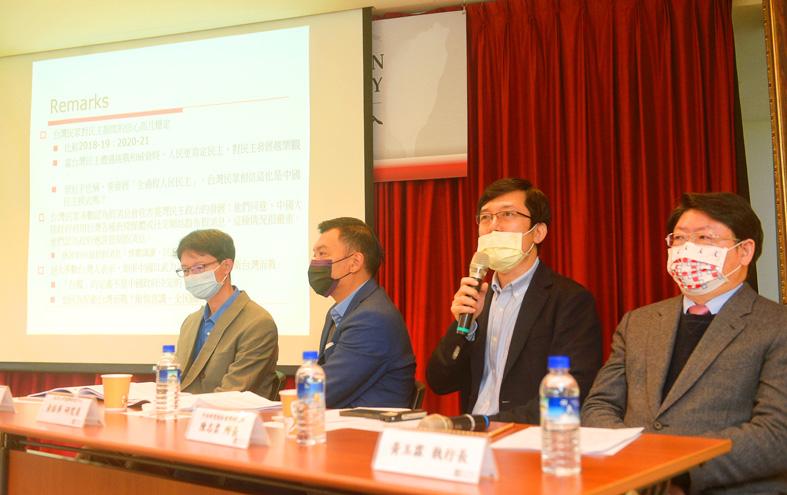Most Taiwanese, or 72.5 percent, are willing to fight for the nation in the event that China uses force to achieve unification, a poll released yesterday by the Taiwan Foundation for Democracy found.
However, asked whether they would fight against China if it attacked after Taiwan declared independence, the percentage of respondents who said they would fight fell to 62.7 percent, while 26.7 percent said they would not fight and 10.6 percent had no response, foundation president Huang Yu-lin (黃玉霖) told a news conference in Taipei hosted by the government-affiliated foundation.
The results suggest that the proportion of Taiwanese opposing unification is larger than those advocating Taiwanese independence, said Eric Yu (俞振華), a research fellow at National Chengchi University’s (NCCU) Election Study Center.

Photo: Chang Chia-ming, Taipei Times
A breakdown of the responses by age group showed that young people are more willing to defend the nation against a Chinese invasion, he said.
Showed the statement: “There might be some problems with democracy, but it remains the best system available,” 75.3 percent of respondents agreed, while 14.1 percent disagreed.
The results showed that 53.2 percent of respondents are satisfied with Taiwan’s democratic practices, while 40.6 percent are dissatisfied, with respondents in their 20s being the most satisfied, and those aged 60 or older the most dissatisfied.
More than half of the respondents, or 55.3 percent, are optimistic about the future of Taiwan’s democratic politics, while 36.5 percent are pessimistic, the poll showed.
Young people in Taiwan appear more confident about democracy, a trend that runs counter to the findings in many Western countries, where young people tend to distrust democracy, due to inequality and other social problems, Yu said.
Nostalgia over the nation’s authoritarian regime, which many older Taiwanese seem to have, might account for their having less faith in democracy, he added.
Compared with previous surveys conducted by the foundation, as well as Academia Sinica polls, support for democracy in Taiwan has been rising since last year, which might be due to growing unease toward China because of its increased pressure on the nation, Academia Sinica Institute of Sociology Director Jay Chen (陳志柔) said.
Further discussion might be needed as to what constitutes “Taiwanese independence,” the main point of contention between Beijing and the Democratic Progressive Party (DPP) government over the past few years, he said.
While most Taiwanese are willing to fight for the nation when it is threatened, more discussion is needed about war preparations and “all-out defense,” subjects less explored by the public, Chen said.
Asked about their political affiliation, 43.7 percent of respondents said they are independent or that circumstances change their preference, 26.3 percent identify with the DPP, 16.7 percent with the Chinese Nationalist Party (KMT) and 7.7 percent with the Taiwan People’s Party, while the rest affiliated with other political parties or had no response.
The poll, conducted from Aug. 10 to 15 by the NCCU Election Study Center, collected 1,299 valid responses — 874 via landline phone interviews and 425 via mobile phone interviews.
It has a confidence level of 95 percent and a margin of error of 2.72 percentage points.
This story has been amended since it was first published.

A magnitude 7.0 earthquake struck off Yilan at 11:05pm yesterday, the Central Weather Administration (CWA) said. The epicenter was located at sea, about 32.3km east of Yilan County Hall, at a depth of 72.8km, CWA data showed There were no immediate reports of damage. The intensity of the quake, which gauges the actual effect of a seismic event, measured 4 in Yilan County area on Taiwan’s seven-tier intensity scale, the data showed. It measured 4 in other parts of eastern, northern and central Taiwan as well as Tainan, and 3 in Kaohsiung and Pingtung County, and 2 in Lienchiang and Penghu counties and 1

FOREIGN INTERFERENCE: Beijing would likely intensify public opinion warfare in next year’s local elections to prevent Lai from getting re-elected, the ‘Yomiuri Shimbun’ said Internal documents from a Chinese artificial intelligence (AI) company indicated that China has been using the technology to intervene in foreign elections, including propaganda targeting Taiwan’s local elections next year and presidential elections in 2028, a Japanese newspaper reported yesterday. The Institute of National Security of Vanderbilt University obtained nearly 400 pages of documents from GoLaxy, a company with ties to the Chinese government, and found evidence that it had apparently deployed sophisticated, AI-driven propaganda campaigns in Hong Kong and Taiwan to shape public opinion, the Yomiuri Shimbun reported. GoLaxy provides insights, situation analysis and public opinion-shaping technology by conducting network surveillance

Taiwan is gearing up to celebrate the New Year at events across the country, headlined by the annual countdown and Taipei 101 fireworks display at midnight. Many of the events are to be livesteamed online. See below for lineups and links: Taipei Taipei’s New Year’s Party 2026 is to begin at 7pm and run until 1am, with the theme “Sailing to the Future.” South Korean girl group KARA is headlining the concert at Taipei City Hall Plaza, with additional performances by Amber An (安心亞), Nick Chou (周湯豪), hip-hop trio Nine One One (玖壹壹), Bii (畢書盡), girl group Genblue (幻藍小熊) and more. The festivities are to

Auckland rang in 2026 with a downtown fireworks display launched from New Zealand’s tallest structure, Sky Tower, making it the first major city to greet the new year at a celebration dampened by rain, while crowds in Taipei braved the elements to watch Taipei 101’s display. South Pacific countries are the first to bid farewell to 2025. Clocks struck midnight in Auckland, with a population of 1.7 million, 18 hours before the famous ball was to drop in New York’s Times Square. The five-minute display involved 3,500 fireworks launched from the 240m Sky Tower. Smaller community events were canceled across New Zealand’s